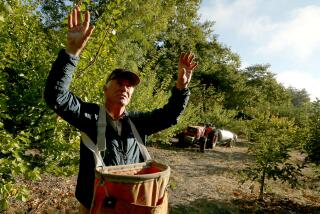Solar Pump Put to Work Where the Wind Fails : Rancher Successfully Converts Windmill Wells
- Share via
MARICOPA, Calif. — Often, the breezes don’t blow when it’s horribly hot and Richard Snedden needs his windmill the most to pump water for his parched cattle. So Snedden switched to a solar-powered pump. He is one of the few farmers in California believed to be using the sun’s power commercially.
“Up here, those really hot days when the cows are really sucking water are also the days when there isn’t any wind; the windmill just wasn’t doing the job for us,” Snedden said during a demonstration of the new technology at his ranch in the inner coast range along the western edge of Kern County.
But that heat generally means that the sun is high in the sky, so Snedden converted two windmill wells to solar-powered pump stations using submersible pumps that are powered by photovoltaic cells that convert sunlight directly into electricity.
One well 140 feet deep produces a gallon of water in less than two minutes when the solar power is working. The water is stored in a tank and watering trough.
“It’s like a spring,” Snedden said. “It pumps every day it’s sunny.”
Cost Less Than $2,000
The smallest solar unit at Snedden’s ranch, which his family has owned for eight decades, cost less than $2,000 to install. Two solar cells produce a combined power rating of about 100 watts, “or about as much energy as it takes to run a porch light,” said William Fairbanks, a Cooperative Extension agricultural engineer at University of California, Riverside.
The second well is equipped with five solar panels that power a mechanical piston jack pump that has a rocking beam much like an oil field pump, only smaller. That system pumps more than four gallons of water a minute.
In the long run, Snedden hopes that his solar-powered wells will cost less to maintain and operate than windmills, but in the short run, there were some frustrating problems getting the system converted to solar. However, he feels that most of the headaches are behind him.
At first, sand and scale clogged the inlet to the submersible pump, but Snedden has provided protection to keep the pump from sucking in sand.
Shared Financing
Snedden’s is a demonstration project from which other farmers can learn. It is directed by Fairbanks and Kern County farm adviser Ralph Phillips, a range specialist. Financing was shared by the Kern County Grazing Advisory Committee, state Energy Commission and Kern County Woolgrowers.
Fairbanks feels that this project will show that the time for solar technology “has arrived” down home on the range, because cattle normally roam in extremely isolated areas where the cost of pumping from regular electrical lines can be prohibitive.
“We’re looking at this in its very simplest form here,” he said. “The technology is here. It’s ready to go. For small needs, it’s great.”
Additional experiments with solar-powered water pumps on ranches are scheduled in the Mojave Desert and in Tulare County.
Phillips said researchers also want to try using solar-powered pumps to boost water laterally over a ridge where a gravity system could carry it to cattle over a large area.
More to Read
Inside the business of entertainment
The Wide Shot brings you news, analysis and insights on everything from streaming wars to production — and what it all means for the future.
You may occasionally receive promotional content from the Los Angeles Times.










